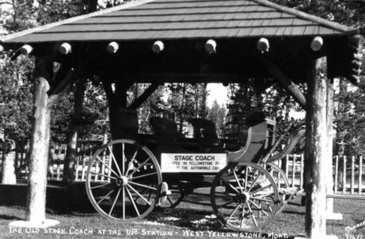Union Pacific Stagecoach Shelter
Introduction
Text-to-speech Audio
When the Union Pacific Railroad first arrived in West Yellowstone in 1908, passengers continued their journey into Yellowstone on stagecoaches. In August 1915, cars were permitted in the park, marking the beginning of the end of stagecoach service. By 1917, cars and buses had completely replaced stagecoaches on Yellowstone's roads. At that time, tour buses began picking up train passengers at the depot.
The stagecoach shelter, located between the baggage building and the dining lodge, was constructed in 1928, over a decade after the end of the stagecoach era. This structure served as a protected location for exhibiting a stagecoach. The stagecoach exhibit was a reminder of the earlier mode of visitor transportation before the rise of the automobile. Today, the structure shelters a picnic table rather than a stage coach. There are some stagecoaches on display on the porch of the former depot, now the Yellowstone Historic Center Museum, located on the east end of the same block.
The stagecoach shelter is an open-sided, single-story, hip-roofed structure. The roof is supported by four full-round, unpeeled logs resting on concrete footings. The roof structure is made from peeled full-round logs, and the roof is finished with cedar wood shingles.
Images
This picture shows the stagecoach shelter when it was still serving its intended use.

Cite This Entry
Center, Yellowstone Historic. "Union Pacific Stagecoach Shelter." Clio: Your Guide to History. December 13, 2017. Accessed April 13, 2025. https://theclio.com/tour/348/4
Sources
"Stagecoach Shelter." Yellowstone Historic Center. http://yellowstonehistoriccenter.org/Stagecoach-Shelter/ (Accessed November 2017).
A & E Architects, P.C. Historic Structures Report: Oregon Shortline. Missoula, MT, July 2001.

